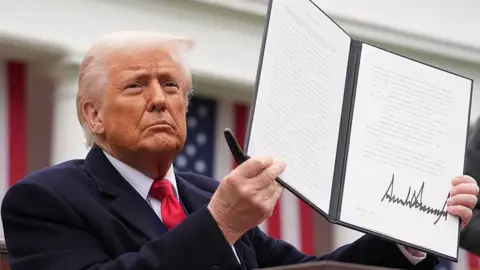The article by Faisal Islam, titled “Trump’s tough tariff tactics are getting results,” explores the implications of President Donald Trump’s tariff strategies, particularly focusing on the negotiations with Japan. As the economics editor for BBC News, Islam provides insights into how these aggressive tactics have started to yield visible results after a period of uncertainty and speculation.
To begin with, Japan is highlighted as a pivotal player in Trump’s reshaping of global trade dynamics. The article indicates that following initial hesitations, there has been a renewed focus on negotiating a deal, which presents a potential success for Trump’s approach to trade. Despite previous setbacks, where discussions seemed to stall, the current developments suggest that Japan has either agreed to or is nearing a favorable trade deal. This could serve as a model for other nations, prompting them to consider similar arrangements with the United States.
The article elaborates on the specifics of the trade relationship, noting that Japan now faces a general tariff of 15% on its goods being exported to the U.S. This figure compares unfavorably with the UK’s tariff rate of 10%, but the UK, unlike Japan, does not maintain a significant trade surplus with the U.S. Such nuances illustrate the differing dynamics at play between nations as they negotiate trade terms with the Trump administration.
As negotiations progressed, it became evident that urgency characterized Japan’s stance, particularly in light of threats from the Trump administration that could impose even higher tariffs. The Japanese finance minister’s comments on the nation’s substantial holdings of U.S. Treasury bonds—as the largest holder globally—indicate Japan’s leverage in these discussions. Rumors surrounding the sale of U.S. bonds by Japanese hedge funds following the announcement of tariffs also reflect a broader unease regarding America’s economic stability.
The context surrounding the deal gains significance when considering Japan’s strategic timing; negotiations took place concurrently with Japan hosting European Union leaders, signifying an attempt to preempt shared retaliatory strategies against U.S. tariffs from major economies. This proactive approach may foster suspicion among EU members as they question why they couldn’t secure a similar deal amidst escalating tensions from the Trump administration.
The article also touches on the repercussions of the tariffs, particularly how they are generating considerable revenue for the U.S. Treasury. With more than $100 billion accrued thus far, tariffs currently contribute around 5% to federal revenue, a substantial increase compared to the typical share of 2%. Predictions suggest that annual tariff revenue could reach $300 billion, signaling a shift in how the U.S. government finances itself.
However, the discussion does not end there; it also highlights the potential burden that these tariffs may place on U.S. consumers. Although the government benefits from tariff revenues, the ultimate cost is likely to fall on American shoppers who will face higher prices for imported goods. The article further notes the depreciation of the U.S. dollar, which has fallen by about 10% against other currencies, exacerbating this situation and impacting import costs.
In the wider context of international trade, the article suggests that the ongoing tussles might ironically bolster China’s standing as a more stable trade partner compared to the precarious position fostered by Trump’s policies. As Japan negotiates gains in agriculture and investment, the overall atmosphere reflects a paradigm shift where established norms of trade agreements might be redefined under Trump’s assertion of American economic power.
In conclusion, the article illustrates that while Trump’s tariffs may bring immediate policies and financial boons, the long-term impacts on consumer prices, international relations, and the overall economic health of the U.S. remain uncertain. The focus on Japan, as both a case study and a potential trendsetter for future trade agreements, emphasizes the complexities that surround these negotiations within a grander narrative of global economic dynamics. The potential shifts in ally relationships and market responses point to a significant period of transformation in international trade spurred by the current U.S. administration.












